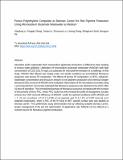| dc.contributor.author | Li, Xiaolong | |
| dc.contributor.author | Zhang, Fengqin | |
| dc.contributor.author | Li, Taotao | |
| dc.contributor.author | Lu, Zhuoxuan | |
| dc.contributor.author | Zhang, Liming | |
| dc.contributor.author | Sauli, Elingarami | |
| dc.contributor.author | He, Nongyue | |
| dc.date.accessioned | 2021-05-05T07:17:28Z | |
| dc.date.available | 2021-05-05T07:17:28Z | |
| dc.date.issued | 2012-10-01 | |
| dc.identifier.uri | https://doi.org/10.1166/asl.2012.4249 | |
| dc.identifier.uri | https://dspace.nm-aist.ac.tz/handle/20.500.12479/1169 | |
| dc.description | This research article published by American Scientific Publishers, Volume 17, Number 1, October 2012 | en_US |
| dc.description.abstract | Abundant acidic wastewater from monosodium glutamate production is difficult to treat, leading to serious water pollution. Utilization of monosodium glutamate wastewater (MSGW) with high concentration of COD (33170 mg/L) as substrates for microbial fermentation is a challenge. In this study, MSGW after diluted was treated under non-sterile conditions by immobilized Monascus purpureus onto porous PE composites. The effects of porous PE composites ( p PEC), initial pH, wastewater concentration and inoculum amount on red pigment production and chemical oxygen demand (COD) removal of MSGW were evaluated. Observation of the microbial community using a scanning electron microscope indicated that Monascus purpureus was attached to the pPEC after 10 days of operation. The immobilized biomass of Monascus purpureus increased with the increase of the porosity of the p PEC. And p PEC could not only increase the yield of red pigment, but also enhance the COD removal efficiency of MSGW. Under the optimal conditions (20% MSGW, pH = 2, 10 mL inoculum), 4.5±0.3 UA500 of red pigment and 53.3±1.8% of COD removal were obtained respectively, when p PEC of 89.79 m2/g in BET specific surface area was applied as biomass carrier. This preliminary study demonstrates that by selecting suitable biomass carrier, proper management of the pH and optimization of application rate, MSGW can be utilized as a nutrient source for Monascus pigment production. | en_US |
| dc.language.iso | en | en_US |
| dc.publisher | American Scientific Publishers | en_US |
| dc.subject | Research Subject Categories::NATURAL SCIENCES | en_US |
| dc.title | Porous Polyethylene Composite as Biomass Carrier for Red Pigment Production Using Monosodium Glutamate Wastewater as Medium | en_US |
| dc.type | Article | en_US |

